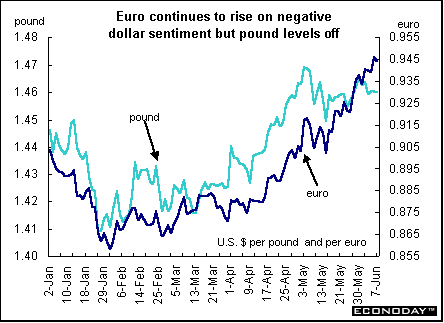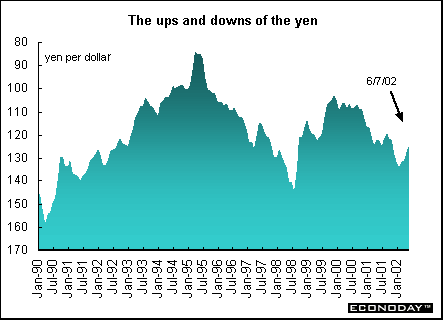CurrenciesHitting a 16-month low, the dollar fell for a ninth week in 10 against the euro. The decline raised concern that foreign investors may begin moving funds out of the world's largest economy. The dollar dipped as low as $0.9485 in reaction to Intel's disappointing sales forecast, which strengthened suspicions that the U.S economic pace has slowed in the second quarter from the strong pace of the first quarter. The dollar appears to be following the equities markets and not paying attention to the overall strength of the U.S. economy relative to other economies. Given the recent memory of the millennium boom, investors may not be accustomed to normal economic growth.  The yen, which is flirting with six-month highs against the dollar, appears to be defying gravity when current economic data are taken into account. For now, the yen's rally against the dollar still appears to have some momentum left, in spite of the immediate threat of new intervention by the Ministry of Finance to slow the currency's gains. During the past two weeks, the MOF has intervened on four main occasions, buying between $15 and $20 billion worth of dollars according to traders’ rough estimates. However, Japan's fragile economic recovery may well turn the yen lower again. The economy is still suffering from deflation and may not be able to kick start growth.  If the yen is stronger than ¥133.00 on September 30, the fiscal-year halfway point, then Japanese companies will be obliged to report foreign exchange losses on their hefty portfolios of foreign assets. And that is a scenario government officials will want to avoid. The latest phase of interventions designed to halt the yen's appreciation reflects worries about the sustainability of the recovery and the competitiveness of Japanese exports. Despite the more optimistic shorter term outlook for the Japanese currency that foreign exchange traders are willing to buy into, others continue to warn that currency markets cannot indefinitely shrug off Japan's key structural weaknesses. The country's debt is approaching 140 percent of gross domestic product, while its banking system, burdened with some ¥150 trillion of bad and potentially non-performing loans, remains in disarray. Even though GDP rose, analysts are skeptical that growth will be sustained given continued contraction of bank credit. |
![[Back To Archive]](../../../images/backtoarchive.gif)